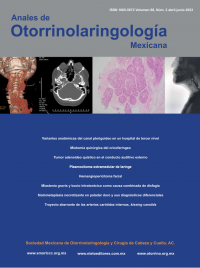
Anatomical variants of the pterygoid canal in a third level hospital.
An Orl Mex. 2023; 68 (2): 47-52. https://doi.org/10.24245/aorl.v68i2.8797
Luis Carlos Sánchez-Paz,1 Mariana Durán-Ortiz,2 Fernando Pineda-Cásarez,2 Itzel López-García,3 Rodolfo Moreno-Sauceda,1 Federico Agustín Moscoso-Cabrera1
1 Médico residente de Otorrinolaringología y Cirugía de Cabeza y Cuello.
2 Médicos adscritos al servicio de Otorrinolaringología y Cirugía de Cabeza y Cuello. Profesores del posgrado.
Hospital Regional General Ignacio Zaragoza, ISSSTE. Facultad Mexicana de Medicina, Universidad La Salle, Ciudad de México.
3 Médico especialista en Otorrinolaringología y Cirugía de Cabeza y Cuello, práctica privada.
Resumen
OBJETIVO: Describir la prevalencia de variantes anatómicas del canal vidiano en otorrinolaringología de acuerdo con la clasificación tomográfica de Lee.
MATERIALES Y MÉTODOS: Estudio transversal, observacional y retrolectivo. Se analizaron estudios tomográficos de nariz y senos paranasales de adultos entre 21 y 90 años que acudieron al ISSSTE del 1 de julio al 31 de octubre de 2022. Se evaluaron las siguientes variables: tipos de variante anatómica del canal pterigoideo según la clasificación de Lee, la dehiscencia del canal y el tipo de neumatización del seno esfenoidal.
RESULTADOS: Se incluyeron 209 pacientes. Prevaleció la variante del canal pterigoideo tipo II de Lee (41.4%), seguida del tipo III (29.4%) y la tipo I (29.2%). Se reportó un 8.2% de asimetría entre ambos canales pterigoideos y un 16% de dehiscencia del techo del canal.
CONCLUSIONES: En esta población mexicana se identifican las siguentes variantes: tipo II de Lee, tipo III y tipo I.
PALABRAS CLAVE: Seno esfenoidal; senos paranasales; México.
Abstract
OBJECTIVE: To describe the frequency of anatomical variants of the vidian canal in otorhinolaryngology patients at a tertiary level hospital according to tomographically Lee’s classification.
MATERIALS AND METHODS: A cross-sectional, observational and retrolective study was done through the analysis of tomographic studies of the nose and paranasal sinuses of adult patients from 21 to 90 years of age who attended the ISSSTE, included from July 1st to October 31st, 2022. Types of anatomical variant of the pterygoid canal of a body according to Lee’s classification were evaluated, as well as the presence or not of canal dehiscence and the type of pneumatization of the sphenoid sinus.
RESULTS: There were included 209 patients. Lee’s type II pterygoid canal variant was found with the highest prevalence (41.4%), followed by type III (29.4%) and type I (29.2%). An 8.2% asymmetry between both pterygoid canals and 16% dehiscence of the canal roof were reported.
CONCLUSIONS: In the Mexican population we confirmed the following prevalence: Lee type II variant, type III and type I.
KEYWORDS: Sphenoid sinus; paranasal sinuses; Mexico.
Recibido: 18 de abril 2023
Aceptado: 26 de abril 2023
Este artículo debe citarse como: Sánchez-Paz LC, Durán-Ortiz M, Pineda-Cásarez F, López-García I, Moreno-Sauceda R, Moscoso-Cabrera FA. Variantes anatómicas del canal pterigoideo en un hospital de tercer nivel. An Orl Mex 2023; 68 (2): 47-52.

